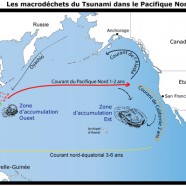Millions of Stowaway Passengers Circling Around the Pacific Ocean
The tsunami which followed the Japanese earthquake devastated around 300km of coastal cities, towns, farmlands and greenhouses along Japan’s Pacific coastline. The wave was reported to have spread up to 10km (six miles) inland and inundated around 500km². Not only did the earthquake and tsunami create an estimated 25 million tonnes of rubble, but when the tsunami receded it dragged with it countless quantities of waste in the flooded zone.
Millions of Stowaway Passengers Circling Around the Pacific Ocean
The tsunami which followed the Japanese earthquake devastated around 300km of coastal cities, towns, farmlands and greenhouses along Japan’s Pacific coastline. The wave was reported to have spread up to 10km (six miles) inland and inundated around 500km². Not only did the earthquake and tsunami create an estimated 25 million tonnes of rubble, but when the tsunami receded it dragged with it countless quantities of waste in the flooded zone.
Millions of Stowaway Passengers Circling Around the Pacific Ocean
The tsunami which followed the Japanese earthquake devastated around 300km of coastal cities, towns, farmlands and greenhouses along Japan’s Pacific coastline. The wave was reported to have spread up to 10km (six miles) inland and inundated around 500km². Not only did the earthquake and tsunami create an estimated 25 million tonnes of rubble, but when the tsunami receded it dragged with it countless quantities of waste in the flooded zone.
The After Shock
Climatic, geological, or anthropogenic natural disasters produce in a couple of seconds, hours or days, enormous amounts of waste, so much so that authorities are unable to handle the quantity with ordinary means. The rupture of “lifelines”, namely water, electricity, transportation routes and communication lines, send survivors into a deep confusion. The accumulation of rubble and waste increases the shock of the populations and postpones the first steps towards the return to normalcy.
The 3 million tonnes of rubble generated by the earthquake in Los Angeles in January 1994 led the city to reinforce and multiply its recycling capacities. Provisional transit and elimination sites for future earthquakes were pre-selected.
The After Shock
Climatic, geological, or anthropogenic natural disasters produce in a couple of seconds, hours or days, enormous amounts of waste, so much so that authorities are unable to handle the quantity with ordinary means. The rupture of “lifelines”, namely water, electricity, transportation routes and communication lines, send survivors into a deep confusion. The accumulation of rubble and waste increases the shock of the populations and postpones the first steps towards the return to normalcy.
The 3 million tonnes of rubble generated by the earthquake in Los Angeles in January 1994 led the city to reinforce and multiply its recycling capacities. Provisional transit and elimination sites for future earthquakes were pre-selected.









